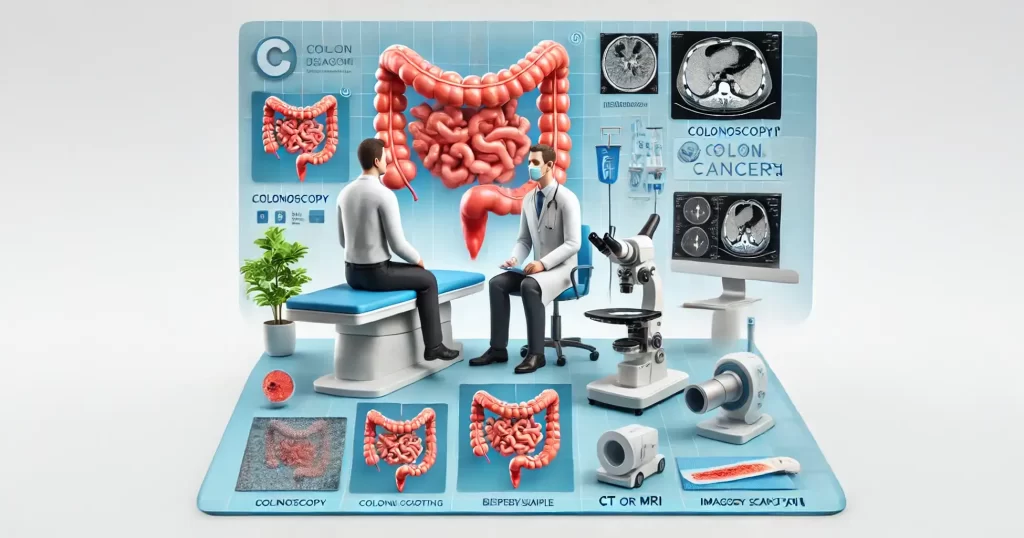Colon cancer stages play a crucial role in understanding the progression and treatment of this common disease. Each stage reflects how far the cancer has advanced, helping doctors create tailored treatment plans and predict outcomes.
Understanding colon cancer stages not only empowers patients but also highlights the importance of early detection in improving prognosis.
In this article, we’ll explore the four stages of colon cancer, what they mean for patients, and how they shape treatment approaches and outcomes. Whether you’re seeking knowledge for prevention or support during a diagnosis, this guide will provide clarity and insight.
What Are Cancer Stages and Why Do They Matter?
Cancer staging is a critical process in understanding the severity and progression of colon cancer. It provides a structured way to assess how far the disease has advanced and where it has spread within the body. Staging not only informs patients about their condition but also equips healthcare providers with the necessary information to devise effective treatment strategies.
How Stages Are Determined
Cancer stages are typically classified based on three key factors, often referred to as the TNM system:
- Tumor (T): The size and extent of the primary tumor.
- Nodes (N): Whether cancer has spread to nearby lymph nodes.
- Metastasis (M): Whether cancer has spread to distant organs or tissues.
By combining these factors, doctors assign a stage ranging from 0 to 4, with Stage 0 representing very early cancer and Stage 4 indicating advanced cancer that has spread to other parts of the body.

Why Staging Matters
Accurate staging plays a pivotal role in:
- Treatment Planning: Tailoring treatments like surgery, chemotherapy, or radiation to the cancer’s specific characteristics.
- Prognosis: Providing insight into survival rates and potential outcomes.
- Monitoring Progress: Helping doctors assess how well treatments are working over time.
Understanding the stages of colon cancer empowers patients to make informed decisions and work closely with their healthcare team for the best possible outcomes.
The Four Stages of Colon Cancer
Colon cancer progresses through four distinct stages, each reflecting the severity and spread of the disease. Understanding these stages helps patients and healthcare providers make informed decisions about treatment and management.

Stage 0: Carcinoma in Situ
Stage 0, also known as carcinoma in situ, is the earliest form of colon cancer. At this stage, abnormal cells are confined to the innermost lining of the colon and have not spread to nearby tissues.
- Characteristics: The cancer is localized and non-invasive, presenting as a small lesion or polyp on the colon lining.
- Importance of Early Detection: Stage 0 is highly treatable if detected early, with almost a 100% survival rate.
- Treatment Options: The most common treatment is a polypectomy, a procedure that removes the polyp during a colonoscopy. In some cases, more extensive surgery may be required.
Stage I: Localized Cancer
At Stage I, the cancer begins to invade deeper layers of the colon wall but remains confined to the colon and has not reached the lymph nodes or other organs.
- Characteristics: Cancer spreads from the innermost layer (mucosa) to the middle layer (submucosa) of the colon wall.
- Symptoms: Early symptoms may include minor changes in bowel habits, mild abdominal discomfort, or blood in the stool, though many patients remain asymptomatic.
- Diagnostic Methods: Colonoscopy and imaging studies like CT scans are commonly used to identify and confirm Stage I cancer.
- Treatment: Surgery to remove the affected portion of the colon, known as a colectomy, is typically the primary treatment. Chemotherapy is rarely needed at this stage.
Stage II: Cancer Spread to Nearby Tissues
In Stage II, the tumor grows beyond the colon wall but has not yet reached the lymph nodes or distant organs. It is further divided into subcategories based on the extent of spread:
- Stage IIA: Cancer has grown through the colon wall but has not spread to nearby organs.
- Stage IIB: The tumor extends into nearby tissues or structures without invading the lymph nodes.
- Stage IIC: Cancer penetrates surrounding organs or tissues but still avoids lymph nodes.
- Symptoms: Persistent abdominal pain, changes in bowel habits, and visible blood in the stool are more common.
- Treatment: Surgery remains the primary treatment. Depending on factors like tumor characteristics and patient health, adjuvant chemotherapy may be recommended to reduce the risk of recurrence.
Stage III: Regional Spread
Stage III is marked by cancer spreading to nearby lymph nodes but not to distant organs. This stage is further categorized:
- Stage IIIA: Cancer involves up to three lymph nodes and has penetrated the submucosa or muscular layer of the colon.
- Stage IIIB: Tumor invades nearby tissues and involves four or more lymph nodes.
- Stage IIIC: Cancer affects multiple lymph nodes and nearby structures.
- Symptoms: More pronounced abdominal pain, fatigue, significant weight loss, and frequent bowel obstruction are common.
- Treatment: Aggressive intervention is required, including:
- Surgery to remove the tumor and affected lymph nodes.
- Adjuvant chemotherapy to target remaining cancer cells.
- Radiation therapy in some cases to reduce tumor size or address symptoms.
Stage IV: Metastatic Cancer
Stage IV is the most advanced stage of colon cancer, where cancer spreads to distant organs such as the liver, lungs, or peritoneum.
- Characteristics:
- Stage IVA: Cancer spreads to one distant organ or site.
- Stage IVB: Cancer spreads to multiple organs or sites.
- Stage IVC: Cancer reaches the peritoneum and/or distant lymph nodes.
- Symptoms: Severe symptoms include intense abdominal pain, jaundice (if the liver is affected), persistent fatigue, and significant weight loss.
- Treatment: While Stage IV is challenging to treat, options focus on prolonging life and improving quality of life:
- Targeted therapies such as monoclonal antibodies.
- Systemic chemotherapy to slow progression.
- Palliative care to manage symptoms and improve comfort.
Understanding the stages of colon cancer is essential for recognizing the disease’s progression and pursuing the most effective treatment options. Early detection through regular screenings can make a significant difference in outcomes and survival rates.
How Colon Cancer Is Diagnosed
Accurate diagnosis is the cornerstone of effective colon cancer treatment. Understanding the diagnostic methods used by medical professionals can help patients feel informed and empowered during their journey.
Common Diagnostic Methods
- Colonoscopy: This is the gold standard for detecting colon cancer. During this procedure, a flexible tube with a camera is inserted into the colon to identify abnormal growths or polyps. If suspicious areas are found, a biopsy may be taken.
- Imaging Tests: Techniques like CT scans, MRIs, and PET scans provide detailed images of the colon and surrounding areas, helping to identify the extent of tumor growth and whether it has spread.
- Biopsy: A sample of tissue is removed during a colonoscopy and examined under a microscope to confirm the presence of cancer cells.
Role of Genetic Testing in Advanced Cases
In cases of advanced colon cancer, genetic testing can identify mutations like KRAS, NRAS, or MSI-H (microsatellite instability-high). These tests are crucial for determining targeted therapy options and understanding the genetic factors contributing to cancer progression.

How Staging Is Confirmed
Staging involves multiple tests and procedures, including:
- Imaging Scans: CT or MRI scans assess the tumor’s size and whether it has spread to lymph nodes or distant organs.
- Pathology Reports: A pathologist examines the biopsy sample to determine the cancer’s type and aggressiveness.
- Blood Tests: Levels of tumor markers like CEA (carcinoembryonic antigen) may help assess the severity and progression of the disease.
By combining these diagnostic tools, healthcare providers can create a comprehensive treatment plan tailored to the patient’s stage and condition.
Treatment Options Based on Stages
Understanding treatment options for colon cancer involves recognizing how they vary across stages and patient-specific factors. Here’s a breakdown of the most effective methods:
Overview of Treatments Across Stages
- Surgery: The cornerstone of treatment for most stages, especially in early stages like Stage I or II, where removing the tumor can be curative.
- Chemotherapy: Often used for Stages III and IV to target cancer cells that have spread beyond the colon. It can also follow surgery to reduce recurrence.
- Radiation Therapy: Common in cases where the tumor is difficult to access or in rectal cancers to shrink tumors before surgery.
- Immunotherapy: Leveraging the immune system to attack cancer, particularly effective for patients with specific genetic markers.
- Targeted Therapy: Using drugs to target specific mutations or pathways in Stage IV metastatic cancers.
Personalized Care Plans
- Patient-Specific Factors:
- Age and overall health influence the type and intensity of treatments.
- Genetic testing identifies candidates for immunotherapy or targeted therapies.
- Patient preferences, especially regarding aggressive treatments in later stages, guide decision-making.
- Combination Approaches:
- A multidisciplinary approach combining surgery, chemotherapy, and radiation is often required for advanced stages.
- Clinical trials may be an option for cutting-edge treatments.
Innovations in Colon Cancer Treatment
- Minimally Invasive Surgeries: Laparoscopic and robotic surgeries are reducing recovery times and improving outcomes.
- Precision Medicine: Treatments tailored to the patient’s genetic makeup are showing promise.
- Advances in Immunotherapy: New drugs are being developed that provide hope for long-term remission, even in advanced cases.
Tailored treatment plans and innovative techniques offer hope and improve survival rates for those diagnosed with colon cancer. Early diagnosis and proactive treatment play a pivotal role in achieving the best outcomes.
Prognosis and Survival Rates by Stage
Understanding the prognosis and survival rates of colon cancer at different stages highlights the importance of early detection and effective treatment. Here’s a closer look at survival expectations and how timely care can make a significant difference.
Survival Rate Statistics for Each Stage
- Stage 0: Carcinoma in Situ
- The survival rate is nearly 100% when detected and treated early, as the cancer is confined to the colon’s innermost layer.
- Stage I: Localized Cancer
- Patients have a 90-95% five-year survival rate due to the cancer being localized and highly treatable with surgery.
- Stage II: Cancer Spread to Nearby Tissues
- Survival rates drop slightly to 75-85%, depending on subcategories (IIA, IIB, IIC) and the extent of tumor penetration beyond the colon wall.
- Stage III: Regional Spread
- When lymph nodes are involved, the five-year survival rate ranges between 50-70%, with aggressive treatment improving outcomes.
- Stage IV: Metastatic Cancer
- Survival rates drop significantly, with about 10-15% of patients living beyond five years. Targeted therapy and immunotherapy have improved outcomes for some patients.
Importance of Early Detection and Treatment Adherence
- Early Detection Saves Lives:
- Diagnosing cancer at Stage 0 or I offers the best chances for curative treatment.
- Routine screenings such as colonoscopies can catch cancer before it spreads.
- Treatment Adherence Matters:
- Completing prescribed treatments like chemotherapy or radiation significantly increases survival chances.
- Regular follow-ups ensure any recurrence is detected and treated promptly.
Real-Life Examples of Improving Outcomes Through Timely Care
- Patient Story: Successful Treatment in Stage II
- A 55-year-old diagnosed with Stage II colon cancer underwent surgery and completed adjuvant chemotherapy, achieving full remission within a year.
- Overcoming Stage IV Challenges:
- A Stage IV patient benefited from a combination of targeted therapy and surgery to remove liver metastases, extending their life expectancy by several years.
Prognosis and survival rates depend heavily on early detection, the cancer stage at diagnosis, and adherence to a comprehensive treatment plan. Advances in medical care are helping improve outcomes and offering hope to patients and their families.
FAQs About Colon Cancer Stages
Can colon cancer be cured at any stage?
- Early Stages (0 and I): Colon cancer detected at these stages is highly curable, often through surgery alone. The cancer is localized, making complete removal effective in most cases.
- Stage II and III: While more advanced, these stages can often be treated successfully with a combination of surgery, chemotherapy, and radiation. The goal is to eliminate cancer and prevent recurrence.
- Stage IV: While a cure is less likely, advancements in treatments such as targeted therapy and immunotherapy can extend life expectancy and improve quality of life. In rare cases, aggressive treatment has led to remission.
What does “in remission” mean for colon cancer?
- Complete Remission: This means no detectable signs of cancer remain after treatment. Regular follow-ups and monitoring are essential to catch any potential recurrence early.
- Partial Remission: The cancer has shrunk but has not disappeared entirely. Further treatment may be necessary to manage the disease.
- Ongoing Monitoring: Patients in remission often undergo routine screenings and tests to ensure the cancer does not return or progress.
How often should you get screened for colon cancer?
- Average Risk Individuals:
- Begin regular screenings at age 45, continuing every 10 years if results are normal.
- High-Risk Groups:
- People with a family history of colon cancer or conditions like inflammatory bowel disease should begin screenings earlier, often by age 40 or sooner.
- More frequent screenings may be recommended, such as every 3-5 years.
- Post-Treatment:
- Patients treated for colon cancer should follow a personalized screening schedule set by their doctor to monitor for recurrence.
Understanding these frequently asked questions helps clarify the importance of early detection, regular screenings, and staying informed about your treatment and prognosis.
Conclusion
Understanding colon cancer stages is crucial for timely diagnosis, effective treatment, and improved outcomes. Each stage presents unique challenges, but advancements in medical science have made early detection and tailored treatments more accessible than ever. Whether it’s recognizing the early signs, undergoing appropriate screenings, or staying informed about treatment options, taking proactive steps can make a significant difference in survival rates and quality of life.
If you or someone you love is at risk or experiencing symptoms, consult with a healthcare professional to get screened and create a personalized care plan. Early detection saves lives, and staying vigilant about your health is the best way to ensure a brighter, healthier future.
Remember, regular check-ups, a healthy lifestyle, and an open dialogue with your doctor can empower you to manage risks effectively. Let’s prioritize prevention and awareness to combat colon cancer together.
Resource
- American Cancer Society: Understanding Colon Cancer
Link: https://www.cancer.org/cancer/colon-rectal-cancer.html


0 thoughts on “Colon Cancer Stages Explained: What You Need to Know”